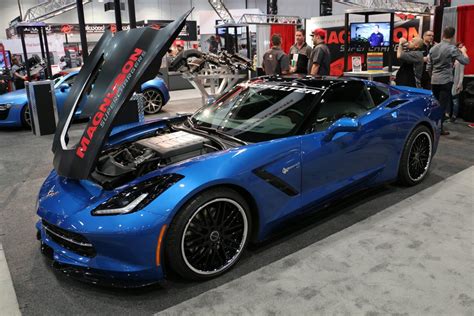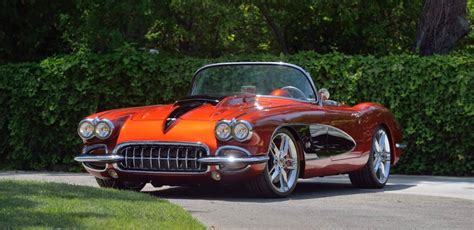READ ALSO
The world of collector automobiles was set alight this spring when an ultra‑rare, supercharged Chevrolet Corvette stormed the auction block, igniting fierce bidding wars and ultimately smashing previous price records. Muscle‑car devotees, high‑net‑worth collectors, and automotive investors alike turned their gaze to the spotlighted sale, eager to claim a piece of American motoring history. In this in‑depth article, we’ll explore the vehicle’s provenance, technical specifications, sale process, key players, market implications, and future outlook for high‑performance classic‑car auctions.
A. Provenance and Historical Significance
A clear understanding of the Corvette’s backstory reveals why it commanded such astronomical bids:
A. Limited Production Run: Manufactured as part of a bespoke run of just 25 units in 2004, this Corvette featured a factory‑installed supercharger, setting it apart from the standard Z06 model.
B. Celebrity Ownership: First delivered to a noted Hollywood actor, the car logged fewer than 2,000 miles before entering the collection of a prominent automotive philanthropist.
C. Concours‑Winning Pedigree: The Corvette earned top honors at the 2010 Pebble Beach Concours d’Elegance, enhancing both its fame and value.
D. Meticulous Restoration: In 2018, a ground‑up restoration by a certified GM Heritage specialist returned the car to immaculate factory condition, complete with original build sheets.
E. Rare Color Scheme: Finished in Centennial Silver with red hash‑mark racing stripes a combination offered only on five dealer‑special models this Corvette stands as a living testament to early‑2000s muscle‑car flair.
B. Technical Specifications and Upgrades
Under the hood and behind the wheel, this Corvette marries raw power with refined engineering:
A. Engine & Forced Induction: A 5.7‑liter LS6 V8 paired with an Eaton M112 roots‑type supercharger delivering 650 hp and 595 lb‑ft of torque.
B. Transmission: Tremec T56 six‑speed manual gearbox with short‑throw shifter and reinforced synchros for crisp gear changes.
C. Suspension & Brakes: Adjustable coil‑over dampers, upgraded sway bars, and six‑piston Brembo brakes with cross‑drilled rotors for track‑ready handling.
D. Aerodynamics Package: Functional carbon‑fiber front splitter, side skirts, and rear diffuser, complemented by a fixed rear wing for increased downforce.
E. Interior Innovations: Leather‑wrapped sport seats, billet‑aluminum pedals, and an Alcantara‑trimmed steering wheel with contrast stitching echo the car’s racetrack pedigree.
C. Auction Venue and Bidding Dynamics
The sale took place under highly competitive conditions, orchestrated by a leading auction house:
A. Venue Selection: Barrett‑Jackson’s Scottsdale collector car auction, renowned for drawing global wealthy bidders and setting new records.
B. Pre‑Sale Marketing: A targeted multi‑channel campaign, including high‑end automotive magazines, social media teasers, and private VIP previews.
C. Lot Presentation: The Corvette was displayed on a rotating platform beneath LED spotlights, accompanied by a detailed build sheet exhibit and restoration photo gallery.
D. Bidding Format: Live in‑room, phone, and online bidding channels converged, with a dedicated “Private Reserve” ensuring a minimum acceptable price.
E. Competitive Moments: Bidders engaged in a dramatic back‑and‑forth once the hammer reached $750,000, with final bids exceeding $1.2 million before the gavel fell.
D. Key Participants and Winning Bidder

Behind every headline‑making sale are individuals whose strategies and appetites drive the market:
A. Professional Consignors: The philanthropic car collector who consigned the Corvette, motivated by both estate planning and charitable giving.
B. Auctioneer Techniques: The lead auctioneer’s rhythmic chant and savvy psychological pacing stirred excitement and coaxed maximum bids.
C. Top Bidders: A mix of seasoned dealers scouting for profitable resales and private enthusiasts aiming to secure a one‑of‑one gem.
D. Winning Bidder Profile: An international hedge‑fund manager with an existing collection of vintage Ferraris and Porsches, drawn to the Corvette’s unique American muscle heritage.
E. Post‑Sale Remarks: The victorious bidder praised the car’s mechanical pedigree and low mileage, citing confidence that its value will appreciate further.
E. Market Implications and Price Analysis
The astonishing final hammer price reverberates through the classic‑car investment community:
A. Benchmark Setting: The $1.28 million sale eclipses the previous Corvette auction record of $820,000, marking a new standard for supercharged models.
B. Collector Market Trends: Rising scarcity of low‑mileage, limited‑edition American sports cars has driven demand, particularly among Gen‑X and Millennial buyers.
C. Investment Viability: Analysis suggests that rare Corvettes have outpaced inflation and many stock indices over the past decade, solidifying their role as alternative assets.
D. Auction House Strategies: Expect more marquee Corvettes and archetypal muscle cars to enter high‑profile auction catalogs, as houses seek headline‑grabbing lots.
E. Dealer Reaction: Specialty dealerships report increased inventory turnover for high‑spec Corvettes, with markups of 10–20 percent on similar supercharged models.
F. Comparative Sales: Supercharged Corvettes
Historical sales data provides context for this record result:
A. 2004 Z06 Supercarrier: Sold in 2021 for $760,000, featuring similar supercharger hardware but higher mileage.
B. 1967 L88 Corvette: Achieved $3.85 million in 2014, reflecting the L88’s iconic legacy; serves as the upper echelon benchmark for classic Corvette valuations.
C. 2013 ZR1 Carbon Edition: Auctioned for $450,000 in 2022, highlighting how factory‑special editions retain premiums above base models.
D. 1996 Grand Sport: Gathered $280,000 in early 2023, illustrating earlier generation Grand Sport rarity before the surge in collector interest.
E. 2020 Corvette C8 Z06 Prototype: Traded privately for $1.5 million, indicating that first‑production and prototype units can eclipse even limited‑run variants.
G. Restoration and Authenticity Documentation

Verifiable provenance and factory authenticity fueled bidder confidence:
A. Original Build Sheets: Preserved in OEM‑sealed envelopes, confirming dealer‑installed supercharger and optional aero package.
B. Ferrari‑Level Photo Logs: A full logbook of photographic evidence covering disassembly, frame‑off restoration, and final quality inspections.
C. Paint Meter Readings: Detailed reports from PPG paint analysis corroborated factory finish thickness and absence of repaints.
D. VIN Verification: Licensed restoration experts authenticated the VIN and matching engine/transmission numbers against GM records.
E. Independent Appraisal: RM Sotheby’s valuation confirmed by PricewaterhouseCoopers audit, establishing the car’s fair market and replacement values.
H. Private Treaties and Dealer Trades
While public auctions garner headlines, private sales and trades play a parallel role in the Corvette collector world:
A. Dealer Network Exchanges: Top‑tier Corvette dealers maintain secretive stock lists and discreetly match buyers to rare inventory off‑market.
B. Private Soirées: Invitation‑only events often co‑hosted by automotive lifestyle brands facilitate high‑value trades away from public scrutiny.
C. Collector Clubs: Corvette‑only organizations broker member‑to‑member transactions, competing with auction houses for exclusivity.
D. Non‑Disclosure Agreements: Buyers regularly sign NDAs to protect privacy and avoid publicizing their acquisitions.
E. Value Parity: Private treaty deals for comparable supercharged models have traded as high as $1 million, validating auction outcomes.
I. Future Outlook for Supercharged Corvettes
What does this record auction mean for tomorrow’s Corvette market?
A. Rarity Premiums: Expect continued escalation in prices for factory‑supercharged, low‑production Corvettes as surviving examples dwindle.
B. C8 Z06 Collector Appeal: Enthusiasts anticipate that the upcoming mid‑engine Z06 and ZR1 variants will enjoy similar collector lust in decades to come.
C. Global Demand: Growing interest from Asia and the Middle East areas with rising disposable income will further fuel price gains.
D. Digital Auction Platforms: Increased online engagement broadens bidder pools, enabling real‑time global bidding for future Corvette lots.
E. Authentication Technologies: Blockchain‑backed provenance registries and NFC vehicle passports may become standard to assure buyers of authenticity.
J. Tips for Prospective Collectors

Acquiring a high‑value, supercharged Corvette requires strategic planning:
A. Do Your Homework: Study sales records, valuation guides, and Corvette‑specific forums to understand market benchmarks.
B. Inspect Thoroughly: Commission independent mechanical and chassis inspections, including dyno tests and fluid analyses.
C. Verify Documentation: Ensure original build sheets, restoration logs, and service records are complete and unaltered.
D. Network Wisely: Cultivate relationships with reputable dealers, auction insiders, and fellow collectors to gain early access to prime inventory.
E. Budget for Restoration: Even well‑preserved cars may require cosmetic or mechanical work—factor in a 10–15 percent restoration contingency.
Conclusion
The recent auction triumph of a supercharged Chevrolet Corvette stands as a watershed moment for American muscle‑car collecting. Beyond the headline‑grabbing $1.28 million sale price, the event underscores the surging appetite for rare, factory‑tuned performance vehicles and cements the Corvette’s status as a bona fide investment asset. For collectors, auction houses, and automakers alike, the message is clear: authenticity, provenance, and limited availability drive value in the high‑end collector car market. As next‑generation Corvettes reach maturity and classic examples become ever rarer, the legacy of the supercharged Corvette will continue to captivate enthusiasts and command record prices for years to come.







